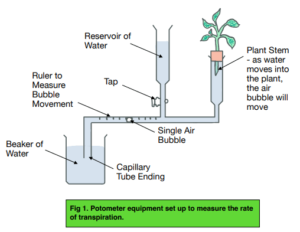Back to: Botany 400 Level
My Afrilearn superstar! How far now? You dey do amazing things with your brain, no cap! Today, we go talk about one cool experiment — how scientists and farmers measure transpiration rates using something called a potometer. Transpiration, na when plants lose water through their leaves, and understanding this process is very important for knowing how plants manage water. So, let’s learn about the potometer, how it works, and how it helps us understand how plants breathe and lose water. Ready? Let’s go!
Measurement of transpiration rates using a potometer
Have you ever noticed how leaves are always a little wet, especially early in the morning? That’s transpiration — the process where water is lost from plants through their leaves. Now, this water loss is part of the plant’s natural “breathing” process, and it’s very important for nutrient uptake and cooling the plant. But how do we measure how much water a plant is losing? That’s where the potometer comes in. It’s a simple tool that helps us measure the rate at which water moves through a plant during transpiration. It’s like a water tracker for plants!

What is a Potometer?
A potometer is a device used to measure the rate of water loss or transpiration in plants. It works by recording the amount of water a plant takes up through its roots, which is almost equal to the amount of water it loses through transpiration. The faster the water is taken up, the higher the transpiration rate. A potometer gives us a visual representation of this process. It’s kind of like measuring how much you sweat during exercise — the more you sweat, the more water your body is losing.
How Does the Potometer Work?
Setup: You start by cutting a healthy plant stem at a slant under water (so no air enters the xylem). You then insert the stem into the potometer and fill the device with water. The potometer is connected to a capillary tube that holds water, and this setup is airtight to prevent any air from entering the system.
Water Movement: As the plant transpires, water is pulled from the soil through the roots, up the stem, and out through the leaves. This creates a negative pressure that draws more water into the potometer from the capillary tube. The water level in the tube will drop as the plant loses water.

Measurement: By marking the water level in the tube and measuring the distance it moves over time, we can calculate the rate of transpiration. If the water moves quickly, that means the plant is losing water rapidly, indicating a high transpiration rate. If the water moves slowly, the transpiration rate is low.
Factors Affecting Transpiration Rate
The potometer can help measure how different factors affect transpiration. For example:
Light Intensity: The brighter the light, the faster the transpiration rate because the plant’s stomata (tiny pores on the leaves) open to release water.
Temperature: On hotter days, plants lose more water through transpiration because the heat increases evaporation.
Humidity: The drier the air, the higher the transpiration rate, because dry air increases the concentration gradient between the leaf and the air, making water move out faster.
Wind Speed: Wind removes water vapor from the leaf surface, increasing the transpiration rate.

Let’s imagine a farmer is studying the transpiration rate of a maize plant. He uses the potometer to measure how much water the plant loses in a given time. He notices that when the plant is exposed to strong sunlight, the water level in the potometer drops very quickly, showing that the plant is losing water at a fast rate. When the maize plant is placed in the shade, the water loss slows down, and the potometer shows a slower rate of transpiration. This shows how sunlight (light intensity) affects transpiration.
Summary
Transpiration is the loss of water from a plant through its leaves, and it’s an important process for nutrient uptake and cooling the plant.
A potometer is a tool used to measure the rate of transpiration by tracking the water movement in a plant.
Factors like light intensity, temperature, humidity, and wind speed can affect transpiration rates.
Evaluation
- What is a potometer, and how does it work to measure transpiration?
- Name two factors that affect the rate of transpiration in plants.
- How can the potometer help us understand the water needs of plants?
- What happens to the water level in the potometer when the transpiration rate is high?
You just learned about how plants lose water and how to measure that water loss using a cool tool like the potometer. The way you’re picking up all this knowledge, you’re going to be a top-notch plant scientist in no time! Keep going strong, and know that Afrilearn has your back every step of the way. You’ve got this —and the next lesson will be just as exciting! Stay awesome!
